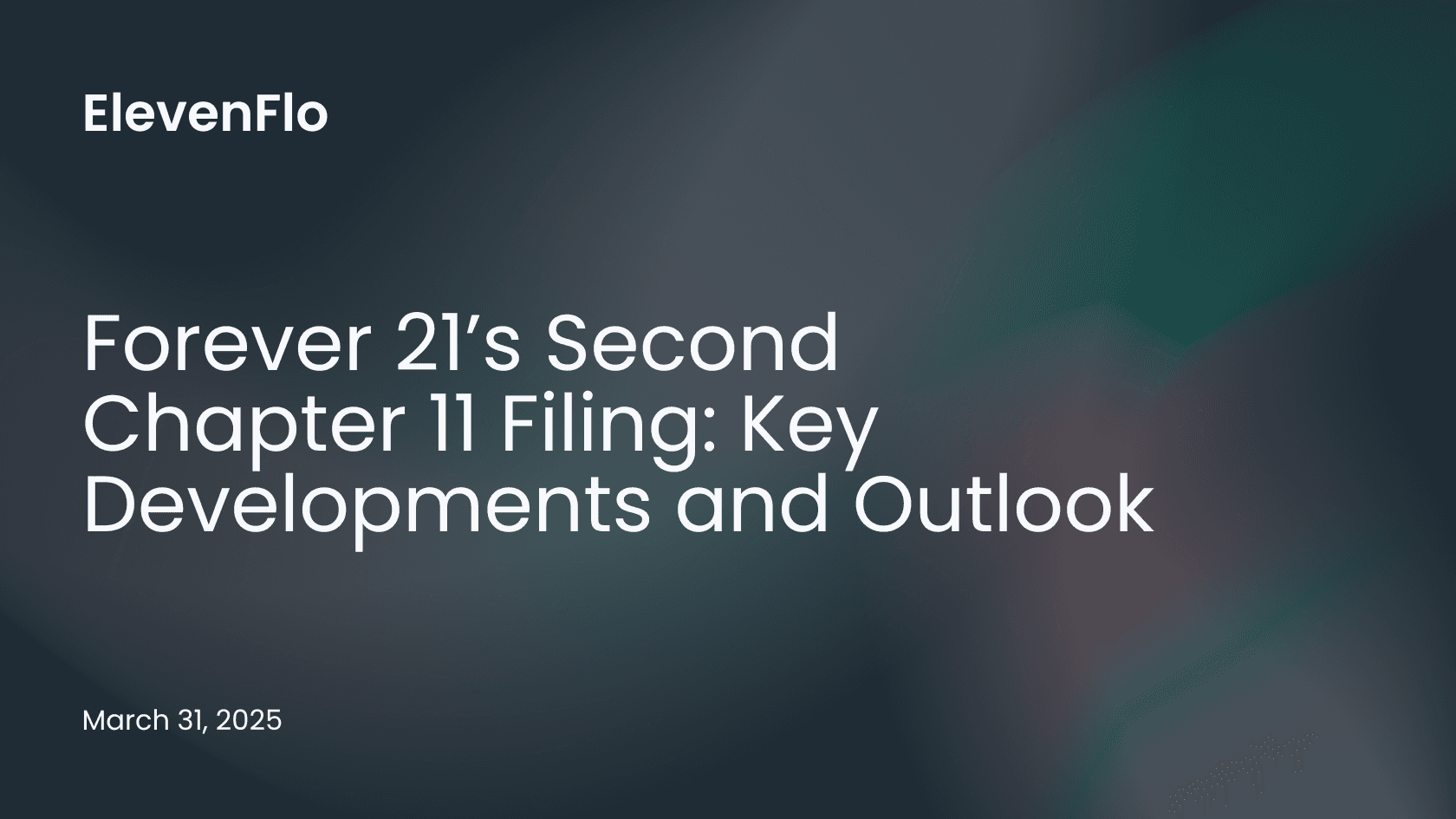Forever 21’s Second Chapter 11 Filing: Key Developments and Outlook

A comprehensive overview of Forever 21’s 2025 Chapter 11 case, covering background, capital structure, and the latest store closing strategy.
Introduction and Background
Fast-fashion retailer Forever 21 filed for Chapter 11 bankruptcy protection on March 16, 2025, marking the company’s second such filing in less than a decade (source; source). Despite successfully reorganizing in 2019, Forever 21 has faced rising inflation, increased competition from online-only retailers leveraging the de minimis exemption (source), and ongoing shifts in consumer spending patterns. Today, the Debtors—F21 OpCo, LLC and its affiliates—are pursuing an orderly liquidation of their U.S. stores and assets, while still exploring potential going concern sale options.
Forever 21’s post-2019 operations initially saw positive results, including $165 million in EBITDA in 2021. However, persistent macroeconomic pressures, along with a high cost structure from leased real estate, contributed to mounting losses—over $400 million in the last three fiscal years alone (source). The Debtors also sought to restructure lease terms and reduce store counts, leading up to the current decision to liquidate.
Forever 21’s Capital Structure and Prepetition Debt
Forever 21’s complex capital structure stems from its integration under the SPARC umbrella (subsequently acquired by JC Penney in December 2024). Under this arrangement, the Debtors inherited certain debt facilities from JC Penney. Each facility is governed by intercreditor agreements that prioritize repayment to the ABL lenders, followed by the Term Loan lenders, and finally the Subordinated Loan lenders.
As of the Petition Date, the Debtors carried approximately $1.582 billion in total funded debt, spread across three main facilities, plus a substantial intercompany payable (the SPARC Payable) owed to an affiliate of SPARC. Below is a summary of the key prepetition facilities.
| Facility | Maturity Date | Outstanding Principal (as of Petition Date) |
|---|---|---|
| ABL Facility | December 2026 | $1.085 billion |
| Term Loan Facility | December 2026 | $321 million |
| Subordinated Loan Facility | May 2027 | $176 million |
- F21 OpCo, LLC: Primary operating Debtor
- F21 Puerto Rico, LLC: Operates five stores in Puerto Rico
- F21 GiftCo Management, LLC: Administers the Debtors’ gift card program
- SPARC Payable: Approximately $320 million owed under intercompany cash pooling
- Subordination: The Term Loan and Subordinated Loans are junior to the ABL Liens
Events Leading to Chapter 11 and Goals of the Filing
Building on the momentum from Forever 21’s previous restructuring, the company generated $165 million in EBITDA in 2021 as pandemic restrictions eased. However, a variety of factors—including persistent inflation, reduced consumer discretionary spending, and competition from non-U.S. retailers—have eroded profitability. By the close of 2024, the Debtors reported total losses exceeding $400 million over the last three fiscal years, with a projected $180 million in additional EBITDA losses expected through 2025.
Although Forever 21 attempted a range of initiatives—such as closing around 34 stores in 2024 and obtaining more than $50 million in rent and licensing fee concessions—it could not generate sufficient momentum to offset rising operational costs and a changing retail environment. The Debtors also pursued informal outreach to potential strategic and financial partners; however, no viable transaction emerged, leading to further consideration of both in- and out-of-court restructuring options.
In January 2025, Forever 21 formed a new Board of Managers tasked with guiding restructuring strategies and investigating possible claims. Shortly thereafter, the Debtors retained experienced legal and financial advisors to conduct a formal marketing process. A total of 217 potential buyers were approached, with approximately 30 parties entering confidentiality agreements and performing due diligence. Despite some initial interest, the Debtors did not secure a definitive going concern sale before their liquidity needs became critical, prompting the decision to commence large-scale store closing sales. Notably, while Forever 21’s online sales were projected to surpass $900 million before the second bankruptcy filing, this strength was insufficient to offset the overall losses (source).
Store Closing Process and Liquidator Joint Venture
In mid-February 2025, Forever 21 initiated its first wave of store closing sales (Wave 1) at approximately 236 underperforming locations. A second wave covering the remaining 118 stores (Wave 2) followed on February 27, 2025, bringing total closures to over 350 (source). The Debtors retained a joint venture of experienced liquidators to manage these sales, ensuring that merchandise—and some furniture, fixtures, and equipment—is liquidated efficiently and in accordance with negotiated consulting agreements.
The Debtors expect to complete all store closing sales before May 1, 2025, with a majority concluding in April (source). Doing so will allow Forever 21 to conserve cash, avoid unnecessary administrative costs, and generate additional liquidity to support the Chapter 11 proceedings. Although liquidation is the primary strategy, the Debtors continue to entertain any compelling go-forward bids from interested parties, should a viable buyer emerge willing to preserve the brand’s U.S. operations in some form.
Lease Rejections and Cost Management
Prior to the Petition Date, Forever 21 had already closed about 17 retail locations and surrendered the corresponding leases. The company filed a motion to reject these leases retroactive to the Petition Date, ensuring it does not accrue further rent obligations for vacant spaces. In the same motion, the Debtors identified several contracts no longer needed, each slated for rejection to limit ongoing expenses that do not benefit the estates.
Overall, these measures reflect the Debtors’ commitment to reducing administrative burdens and maximizing recoveries for creditors, whether through liquidation proceeds, potential assumption and assignment of leases in a possible going concern deal, or other value-enhancing transactions emerging during the Chapter 11 cases.


